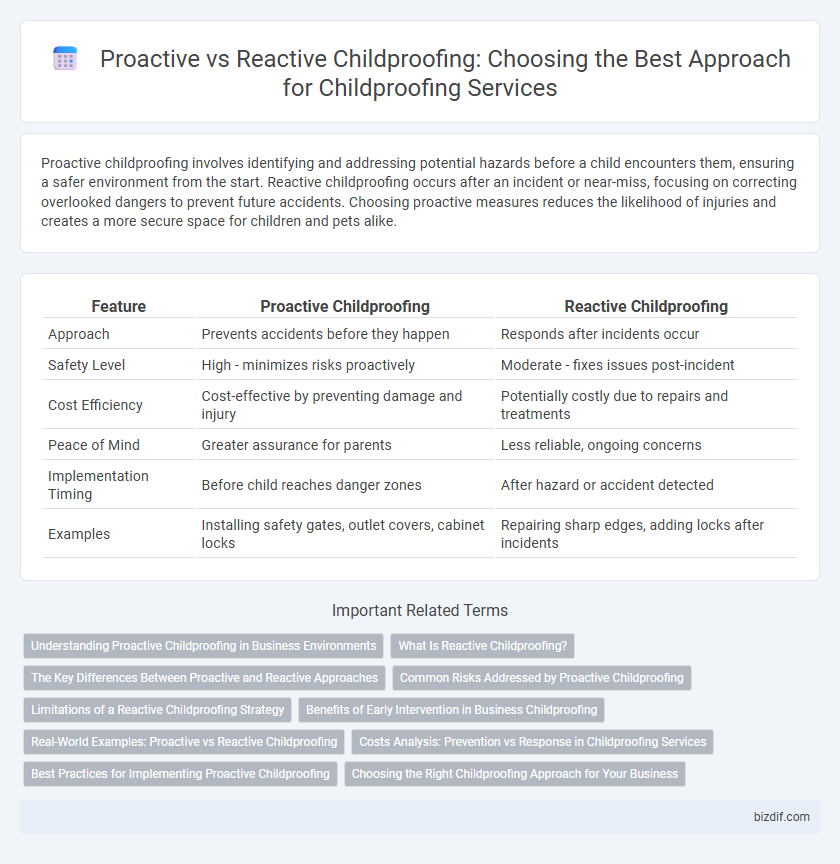Proactive childproofing involves identifying and addressing potential hazards before a child encounters them, ensuring a safer environment from the start. Reactive childproofing occurs after an incident or near-miss, focusing on correcting overlooked dangers to prevent future accidents. Choosing proactive measures reduces the likelihood of injuries and creates a more secure space for children and pets alike.
Table of Comparison
| Feature | Proactive Childproofing | Reactive Childproofing |
|---|---|---|
| Approach | Prevents accidents before they happen | Responds after incidents occur |
| Safety Level | High - minimizes risks proactively | Moderate - fixes issues post-incident |
| Cost Efficiency | Cost-effective by preventing damage and injury | Potentially costly due to repairs and treatments |
| Peace of Mind | Greater assurance for parents | Less reliable, ongoing concerns |
| Implementation Timing | Before child reaches danger zones | After hazard or accident detected |
| Examples | Installing safety gates, outlet covers, cabinet locks | Repairing sharp edges, adding locks after incidents |
Understanding Proactive Childproofing in Business Environments
Proactive childproofing in business environments involves identifying potential hazards before children encounter them, reducing risks and enhancing safety compliance. This approach integrates thorough risk assessments, high-quality safety products, and staff training to prevent accidents rather than responding after incidents occur. Emphasizing proactive strategies fosters a safer environment, minimizes liability, and promotes trust among parents and clients in childcare facilities and family-focused businesses.
What Is Reactive Childproofing?
Reactive childproofing involves addressing safety hazards only after an incident or near-miss has occurred, rather than anticipating potential dangers beforehand. This approach often leads to temporary fixes and increased risks as it responds to accidents rather than preventing them. Implementing proactive childproofing strategies minimizes the need for reactive measures by identifying and neutralizing risks before children encounter them.
The Key Differences Between Proactive and Reactive Approaches
Proactive childproofing involves implementing safety measures before any incidents occur, focusing on hazard identification and prevention to create a secure environment for children. Reactive childproofing responds to accidents or near-misses by addressing vulnerabilities after they have been exposed. The key difference lies in timing and prevention strategy, with proactive approaches reducing risk beforehand and reactive methods mitigating existing dangers.
Common Risks Addressed by Proactive Childproofing
Proactive childproofing addresses common household risks such as electrical outlets, sharp furniture edges, and toxic substances before accidents occur, reducing the likelihood of injuries. Installing safety gates, securing cabinets, and using corner protectors are essential measures to prevent falls, poisoning, and cuts in children. This approach ensures a safer environment by eliminating hazards proactively rather than responding to incidents after they happen.
Limitations of a Reactive Childproofing Strategy
Reactive childproofing often addresses hazards only after an incident occurs, limiting its effectiveness in preventing injuries. This approach relies heavily on identifying risks post-accident, which can leave children exposed to unseen dangers until damage is done. Proactive childproofing anticipates potential threats, creating safer environments by reducing the likelihood of accidents before they happen.
Benefits of Early Intervention in Business Childproofing
Proactive childproofing in business settings prevents accidents by identifying and addressing hazards before incidents occur, reducing liability and enhancing safety compliance. Early intervention lowers the risk of costly legal claims and ensures a secure environment for employees and visitors, promoting a positive corporate reputation. Implementing proactive measures leads to long-term savings by minimizing disruptions and maintaining uninterrupted operations.
Real-World Examples: Proactive vs Reactive Childproofing
Proactive childproofing involves identifying and addressing potential hazards before incidents occur, such as installing safety gates and securing cabinets to prevent accidents. Reactive childproofing occurs after an incident, like adding corner guards following a child's fall or relocating electrical cords after a near-electrocution. Real-world examples highlight that proactive measures significantly reduce injury risks and create safer environments compared to reactive responses that often address problems only after harm has happened.
Costs Analysis: Prevention vs Response in Childproofing Services
Proactive childproofing significantly reduces long-term expenses by preventing accidents and minimizing emergency medical costs, property damage, and liability risks. Reactive childproofing involves higher costs due to urgent repairs, treatment for injuries, and potential legal fees following incidents. Investing in comprehensive preventive measures offers greater financial efficiency and safety assurance for families.
Best Practices for Implementing Proactive Childproofing
Implementing proactive childproofing involves conducting thorough hazard assessments and installing safety devices such as outlet covers, cabinet locks, and corner guards before children encounter risks. Regularly updating safety measures based on the child's developmental stages ensures continuous protection and minimizes accidents. Educating caregivers on anticipated dangers and prevention techniques fosters a safer environment, reducing the need for reactive interventions.
Choosing the Right Childproofing Approach for Your Business
Proactive childproofing involves anticipating potential hazards and implementing safety measures before incidents occur, ensuring a safer environment for children and reducing liability risks. Reactive childproofing addresses safety concerns only after an accident or issue arises, which can lead to higher costs and damage to your business reputation. Choosing the right childproofing approach for your business means prioritizing proactive strategies to maintain compliance with safety regulations and build trust with parents and caregivers.
Proactive childproofing vs Reactive childproofing Infographic

 bizdif.com
bizdif.com